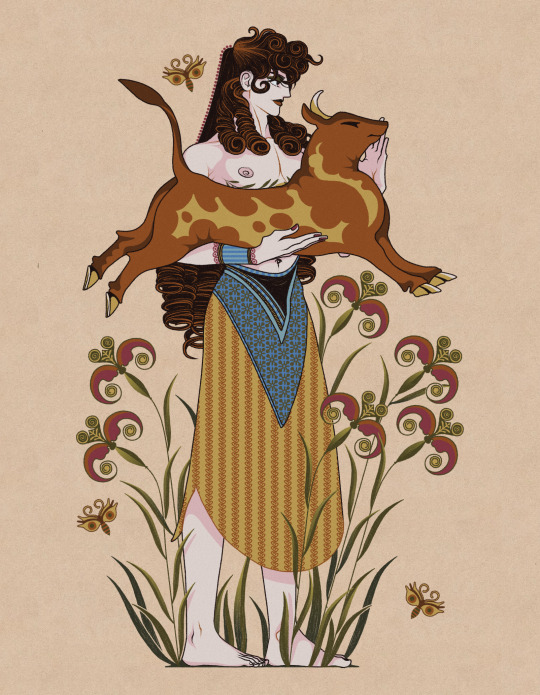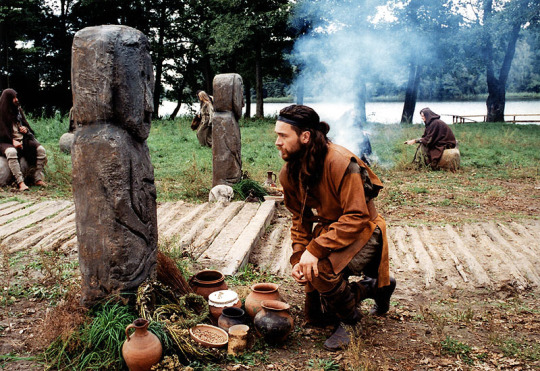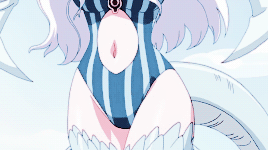Text

Minoan trans man.. I'd like to think he's a saffron goddess who may have been playing tricks but made a realization in the process 🐂➰
3K notes
·
View notes
Text
“For still there are so many things that I have never seen: in every wood in every spring there is a different green.”
— J.R.R. Tolkien, The Lord of the Rings: The Fellowship of the Ring, “The Ring Goes South”
2K notes
·
View notes
Text
Classic lit isn't relatable TO YOU. I have something wrong with me though
30K notes
·
View notes
Text
I hate it when people are like “get out of your comfort zone” literally every single thing I do in my life feels like me getting out of my comfort zone
55K notes
·
View notes
Text
One of the most dangerous things in the world is not being able to say no to people because you don't want to upset them or dissapoint them. This will completely ruin your life in every way possible, at work, in your private life, your sex life and your friendships. It's a way of removing your own consent in your own decisions and go against your wishes, it is always a crime against yourself. Let yourself have a say. Upsetting people is better than traumatizing yourself.
88K notes
·
View notes
Text
The Ultimate Dark Academia Book Recommendation Guide Ever
The title of this post is clickbait. I, unfortunately, have not read every book ever. Not all of these books are particularly “dark” either. However, these are my recommendations for your dark academia fix. The quality of each of these books varies. I have limited this list to books that are directly linked to the world of academia and/or which have a vaguely academic setting.
Dark Academia staples:
The Secret History by Donna Tartt
If We Were Villains by M.L. Rio
Dead Poets Society by Nancy H. Kleinbaum
Vita Nostra by Maryna Dyachenko
Dark academia litfic or contemporary:
Bunny by Mona Awad
The Idiot by Elif Batuman
These Violent Delights by Micah Nemerever
White Ivy by Susie Yang
The Cloisters by Katy Hays
Never Let Me Go by Kazuo Ishiguro
The Lake of Dead Languages by Carol Goodman
A Separate Peace by John Knowles
Black Chalk by Christopher J. Yates
Attribution by Linda Moore
Dark academia thrillers or horror:
In My Dreams I Hold a Knife by Ashley Winstead
The Maidens by Alex Michaelides
Ghosts of Harvard by Francesca Serritella
Catherine House by Elisabeth Thomas
Plain Bad Heroines by Emily M. Danforth
They Never Learn by Layne Fargo
The It Girl by Ruth Ware
Never Saw Me Coming by Vera Kurian
Dark academia fantasy/sci-fi:
Babel: An Arcane History by R.F. Kuang
The Atlas Six by Olivie Blake
Ninth House by Leigh Bardugo
A Lesson in Vengeance by Victoria Lee
The Starless Sea by Erin Morgenstern
Vicious by V.E. Schwab
A Discovery of Witches by Deborah Harkness
The Betrayals by Bridget Collins
Dark academia romance:
Gothikana by RuNyx
Alone With You in the Ether by Olivie Blake
Dark academia YA or MG:
Truly Devious by Maureen Johnson
A Deadly Education by Naomi Novik
Ace of Spades by Faridah Àbíké-Íyímídé
The Raven Boys by Maggie Stiefvater
Legendborn by Tracy Deonn
Crave by Tracy Wolff
Wilder Girls by Rory Power
The Harry Potter series by J.K. Rowling
Dark academia miscellaneous:
My Dark Vanessa by Kate Elizabeth Russell
Disorientation by Elaine Hsieh Chou
Alphabet of Thorn by Patricia A. McKillip
10K notes
·
View notes
Photo


🌌 Guiding Light of Dharma 🌷🌠
support me on pixiv fanbox
melontoyo.fanbox.cc
780 notes
·
View notes
Text
Kōshin
Kōshin (庚申) or Kōshin-shinkō (庚申信仰) is a folk faith in Japan with Taoist origins, influenced by Shinto, Buddhism and other local beliefs. A typical event related to the faith is called Kōshin-kō (庚申講), held on the Kōshin days that occur every 60 days in accordance with the Chinese sexagenary cycle.
On this day some believers stay awake to prevent Sanshi (三尸), entities believed to live inside the body of believers, from leaving it during that night in order to report the good and specially the bad deeds of the believer to the god Ten-Tei.
It is not clearly certain when such custom arrived or came into fashion in Japan, although it is believed that by some time in the 9th century it had been already practiced at least by aristocrats. A Japanese monk called Ennin wrote in his travel book upon visiting Tang China in 838, that “Tonight people are not sleeping. It is the same as in our country on Kōshin nights.” In the Muromachi period, Buddhist monks started to write about the Kōshin, which led to wider popularity of the faith among public. Numerous monuments or pillars called Kōshin-tō (庚申塔) (or also Kōshin-zuka (庚申塚)) were erected all over the country and the faith remained very popular through the Edo period. When the Meiji Government issued the Shinto and Buddhism Separation Order in 1872, folk beliefs were turned down as superstitious, Kōshin belief too losing popularity as a result.
Today, the Kōshin belief still survives, although it is far less popular and receives smaller recognition than it once did, due to the absence of any central organization to help promote such faith because of its folkloric nature. While many Kōshin-tō were moved, for example, to inside Buddhist temples or even to private houses to be protected, there are many remaining along historical roads as well. There are also well maintained Kōshin-dō (庚申堂), built in respect for the Kōshin, sometimes attached to Buddhist temples, or otherwise in stand-alone.

59 notes
·
View notes
Text
Things Westerners Need to Know About Shintō
We worship kamisama, not ‘gods’. If you have to, ‘deities’ is OK to say but kami are not gods.
It is not okay to combine Shinto with anything other than Buddhism, which it has been historically connected with. If you practice something else, keep it separate.
Do not use Shinto or the kami in your western witchcraft or paganism. Those are very separate. Japanese culture has its own methods of sorcery and such which I will not share here as of now.
It is imperative that you use the appropriate suffixes for kamisama. Post on that upcoming.
It’s “Shinto”, not “Shintoism”. “Shinto practitioner” not “Shintoist”.
Don’t exoticize it. Orientalists GTFO.
Shinto is an open tradition. That said, there are certain rules to follow, and you still must keep in mind that you are an outsider to the culture and need to learn about it. Just because it lacks a doctrine does not make it a free-for-all.
1K notes
·
View notes
Text
Japanese New Age Cult Red Flags
Just like any religious community, Shintō and Buddhism are not free from harmful cults -- ranging from spiritual pyramid scheme groups to groups that purchase shrines and take over their administration.
For community benefit, I will list some key red flags, as these groups often post online and expand their following on social media. Please note that context should be paid attention to; use your judgement. If there are multiple traits present in a group, I highly suggest keeping your distance.
Focus on past lives. It is not wrong to believe in reincarnation, but claiming to be a reincarnation of a specific, usually powerful historical figure or kamisama/buddha etc. is an instant red flag.
Talk of Japanese being a secret lost tribe of Israel
Other, usually antisemitic and xenophobic conspiracy theories, including, but not limited to: The Star of David is the same as the kagome-mon. This type of behavior can build off of the same kind of conspiracy theories in the West; there are plenty of Qanon believers in the Japanese religious sphere, unfortunately.
Pseudohistory such as: speaking of the Hitsuki Shinji oracles as legitimate historical texts, or favoring Jindai Moji scripts.
Claims to reconstructed prehistorical Jōmon era religion - this can include some Koshintō movements, so again, use your judgement well.
Reliance on one figure as a central authority, especially when disregarding others.
Reliance on oracles and prophecies heard by one central figure
Putting down other sects or traditions
Circumventing ordainment/training for clergy
Talk of auras, "the spiritual" in a vague sense, referring to shrines and temples as "power spots" (some more normal folks do this last one, but that's because the influence of New Agers is actually pretty significant -- but it decenters the importance of kamisama in a shrine or buddhas/bodhisattvas etc. in a temple).
Focus on prehistoric shamanic queen Himiko, female kamisama and Ryūjin-sama (use your judgement wisely here). TERFy New Age cults exist in Japan as they do elsewhere, and this often is accompanied by focus on Himiko etc.
Overemphasis of shamanic elements of Shintō (while a historic truth, often endangers people with mental illness and lacks healthy balance)
Using nonprofit or charity-type locations that seem secular at a glance to recruit members (the infamous Aum Shinrikyō has two descendant cults which recruit through yoga classes)
Talk of ancient mother goddess worship (influenced by Western pseudohistory, a la Wicca)
Excessive focus on messages and signs from kamisama, usually in the context of shrine visits (this is not to say you cannot have signs, but rather that balance is necessary)
Damaging shrine property; hugging goshinboku
Ignoring or speaking over experts and clergy, especially when asked to stop
Informing other worshippers at a shrine that they are bowing, clapping wrong
Incorporating Western New Age or pagan practices
Focus on healing (with the common sense exception of kamisama or Jizō known for healing)
Suggesting or demanding you buy a product or service, especially for health conditions, job issues etc. There is a reason for the common trope of shady people selling expensive ceramic pots to people who are vulnerable.
Multiple members are romantically or sexually interested in or involved with the leader/central figure.
Recruitment either by lay members or from officials. This situation can be tricky, but most shrines no longer do this. Shrines with official worship groups will have posters and such, but will not prosletyze.
I will add to this list as I see fit. Please do not harass anyone, but rather use these guidelines to set safe boundaries around yourself when considering groups.
1K notes
·
View notes
Text









Slavic mythology from A to Z:
[M] - Mokosh (Мокош) or Makosh is the goddess of the harvest, the giver of wealth. Then she was revered as the goddess of fate. She took care of marriages and marital happiness. Mokosh helped women spin the yarn, but she herself was invisible.
332 notes
·
View notes
Text
Slavic resources in english - collection of academic sources about slavic folklore, paganism and witchcraft

Slavic culture
aka the place to start whether you are curious about the customs of your slavic ancestors, looking into slavic witchcraft or interested in pre-christian slavic religion
Slavic folklore - didactical guidelines by Laima Anglickiene: a great handbook on the subject of slavic folklore in general originally created for the use of lithuanian students
Some of my personal favorites:
Russian folk belief by Linda Ivanits
Russian folk epics by James Bailey and Tatyana Ivanova
Coexistence or Conflict? The Problem of Dual Belief in Polish Folklore by Anna Brzozowska-Krajka
Collection of articles gathered by Lamus Dworski (mostly Western Slavic).

Slavic pantheons
That’s right I said pantheons. There was no one universal pantheon for all slavic tribes and every internet-bred divine family tree that tells you otherwise is misinformation.
Non-academic intro post - why slavic paganism IS NOT CLOSED and why some people claim that it is
The mythology of all races volume III - celtic, slavic by Jan Máchal: I don’t see this little gem mentioned a lot but the slavic section of this book is a great introductory read for people interested in slavic religion 101 course; it’s sadly quite old and we certainly made some more progress since, but when it comes to slavic stuff one just has to work with some older material
Sources of Slavic Pre-Christian Religion by Juan Antonio Àlvarez-Pedrosa: this brilliant (and quite recent) creation compiles all known medieval sources on pre-christian slavic religion, segregated by language.
The gods of Ancient Slavs by Myroslava Znayenko: if you can’t afford the one above there’s always free access to this collection of sources on pre-christian slavic religion; a bit aged publication though
Supernatural beings from Slovenian myth and folktales by Monika Kropej
Journal Studia Mythologica Slavica: some articles were featured in Lamus Dworski’s collection, but much more came out since
Slavonic Pagan Sanctuaries by Leszek Paweł Słupecki: focuses on ancient slavic places of cult - temples, idols, sacred groves etc. and the way they functioned in slavic society and religion
New Researches on the Religion and Mythology of the Pagan Slavs edited by Patrice Lajoye: a great collection of articles about Slavic Paganism, though I wouldn’t recommend it as your very first read on the subject, you can sample it by reading the “Slavic deities of death” linked further on the list.
Baba Yaga. The Ambiguous Mother and Witch of the Russian Folktale by Andreas Johns: in case you wanted to get engaged in the is-she-or-isn’t-she-a-deity discussion
Fierce Feminine Divinities of Eurasia and Latin America by Małgorzata Oleszkiewicz-Peralba: this is a bit of an odd duck in the group as it focuses on four different deities (Baba Yaga, Kali, Pombagira, Santa Muerte) and only one of them Slavic; nonetheless if you are starved for academically approached discussion on Baba Yaga as a goddess you’ll very much enjoy the first part, with other parts being no less captivating although more distant culturally.
Favorite bastard child:
Slavic gods and heroes by Judith Kalik and Alexander Uchitel
Kalik and Uchitel attempt to prove that slavic pantheons as we tend to imagine them nowadays never existed and instead suggest slavs worshipped tribal heroes and tribal totems.
Pros: amazing info about cult of heroes and totemic animals, LOTS of quotes from primary sources, thought-provoking, even if you don’t agree with their conclusions you get to do some critical thinking about your beliefs
Cons: you need critical thinking skills, also not the best book to start your adventure with
Here’s a review of the book by someone better qualified than me.
Collection of my favorite articles that were not listed in the sources above:
Slavic deities of death, looking for a needle in a haystack by Stamatis Zochios
Saint Perun and Saint Volos by James Joshua Pennington
The Role of Legend in Constructing Annual Cycle by Mirjam Mencej
On the concept of Chernebog and Bielbog in Slavic Mythology by Myroslava Znayenko
Sacrifices among the Slavs by Isabella Wenska
The revival of Ukrainian Native Faith by Adrian Ivakhiv
Non-Iranian origin of the Eastern-Slavonic god Xursu/Xors by Constantine Borissoff: okay this one is listed in the Studia Mythologica Slavica link but I just wanted to give it an extra shout out
The Dyadic Goddess and Duotheism in Nodilo’s ‘The Ancient Faith of the Serbs and the Croats’ by Suzana Marjanić
The problem of mysteriousness of Baba Yaga in religious mythology by Evgenia V. Ivanova
Mythical beings punishing breaking of taboos on spinning by Mirjam Mencej
Websites I actully can recommend (supported on academic research):
Słowiański bestiariusz - The Slavic Bestiary
Solntsa Roshcha reconstructionist blog
To be honest at first best avoid all sources that are not academic publications written by specialists on the subject. There’s so much BS about slavic paganism and witchcraft floating on the internet right now you’re just gonna get bombarded with misinformation. And regrettably some slavic online groups spread very problematic ideologies.

Slavic witchcraft
The bathhouse at midnight by W. F. Ryan: the go to book about Slavic witchcraft
Witchcraft Casebook: Magic in Russia, Ukraine, Poland, and the Grand Duchy of Lithuania, 15th-21st Centuries by Valerie Kivelson
Witchcraft in Russia and Ukraine 1000-1900 by Valerie Kivelson and Christine Worobiec
Witchcraft in early modern Poland 1500-1800 by Wanda Wyporska
Charms and charming - studies on magic in everyday life edited by Éva Pócs: a fantastic collection of articles on slavic witchcraft
Charms, charmers and charming: despite similar name this is a different collection of articles from the one above, one section is centered around russian and slavic oral charms, quite Russia-centric
Articles about Polish magic:
Slavic protective magic in the Early Middle Ages on polish territories by Joanna Wawrzeniuk
Witches’ herbs on trial by Michael Ostling
The Curse, On Folk Magic of the Word by Anna Engelking
Articles about Eastern Slavic zagovory:
Russian Ritual Incantations: Traditions, diversity, continuity by Joseph L. Conrad
Sound-shaping of east slavic zagovory by Alla Astakhova
Aspects of Historical Poetics and Pragmatics of Slavic Charms by Pieter Plas and Alexey Yudin
Verbal charms from a 17th century manuscript by Andrei Toporkov
Russian village magic in the late soviet period: one woman’s repertoire of zagovory
Miscellaneous articles:
The role of plant characteristics in slavic folk medicine by V. B. Kolosova
Charmers on the folk practice of charming in Serbia by Sonja Petrović
Waxing Like the Moon: Women Folk Healers in Rural Western Ukraine by Sarah D. Philips
Charms in the context of magic practice. The case of Slovenia by Monika Kropej

🛑 To avoid 🛑
Anything by Dmitry Kushnir
Encyclopedia of Russian and Slavic Myth and Legend - W. F. Ryan’s review for additional info
Illustrated Encyclopedia of Ancient Slavic Gods and Spirits
Slavic-Aryan vedas
Book of Veles
Słowiańska wiedźma
Wikipedia website (it actually has been improved recently but I still advise caution, it’s previous contents teach us that anyone can edit it back into an abomination any time)
Slavorum website
The white goddess website
Wiara przyrodzona website
Any website that offers you a large family tree of slavic gods without making a disclaimer about it being completely fictitious
And many more

1K notes
·
View notes
Text
A stranded rusałka’s guide to; connecting with the old ones
So, this has come up as a subject in the Slavic discord (you should totally join, it is a wonderful place). I have had a number of people ask me what it is I do to connect to the old ones, how do I reach out. So I have decided to make a post, and maybe give a few examples.
Disclaimer; I am by no means some omnipotent being who knows everything and has everything figured out. This is just what I do, based off research, conversations with others and personal experience.
First of all… Pray. A lot of people don’t like that word. For a lot of people, it is a word associated with mindlessly repeating words that are not our own to appease a distant diety. That is not what I mean. Talk to them. The old ones always listen. When I talk to them… I tell them secrets; I tell them about the annoyances and fears. I tell them the mundane; like when I feel low and lonely because the sky is grey and gloomy. The big; like that I am afraid of the shadows the talk to me. And everything in between.
Another way I have found much love for is dedicating my creativity to the old ones. Write, draw, sing and dance. The old ones do not care if you are a professional. Your devotion is enough. The effort and intention counts.
Maintaining an altar for the old ones is a very good way to connect to the old ones; it has the virtue of being as simple or as complex as you wish it to be. You can make it as personal as you wish, decorate it with fruits and flora of the season, your own craft, candles, crystals… Cloths etc. It can be as small as a tin box with a candle light and some leaves, if you have to hide your beliefs or simply don’t have the space. Tending to your altar, adding to it and changing it up is a wonderful exercise of connecting with the old ones.
Along that note, making offerings is another very good way. I have found many people around me struggle to come up with fitting offerings so I will suggest some down below. I personally like to use blood (normally own) as an offering to the two old ones I communicate with most often, as well as baked goods and different flora. Those are rather universal offerings, and can be used in addition/mixed in with other things. So here are a few examples of offerings and altar decorations I make and use;
Morana; dog rose, lilies, poppies, chrysanthemum, crow and raven feathers, fresh blood, bones (I like to use bones from my meals), graveyard dirt, black and white candles, obsidian, labradorite, dried fruits, velvet, rag dolls, pieces of paper with things I’m afraid of
Veles; pine cones, willow leaves, daisies, coins, bear or cattle statuettes, black, grey, and green candles, song lyrics, sheet music, drawings quartz, emerald, lightning stones, most fabrics really, apples, blueberries, raspberries, herbs, incense, secrets I’m not supposed to tell anyone written down on things like napkins, pieces of fabric etc.
Mokosh; roses, lavender, chicken feathers, flowery materials (such as shawls and table cloths), phallic statues and imagery, knitted handywork, locks of hair, sweet foodstuffs, red, brown, white and purple candles, interestingly shaped pebbles, carnelian, drawings, daily matters, such as things I need to remember organised on a list
Perun; oak leaves, nuts, steel, blue and white candles, silk, fresh produce such as bread and spiced meats, leather, celestite, sapphire, lightning imagery, white feathers,
Jarilo; any and all flowers, knives and daggers, braided bread (I’m not sure what it’s called in English), wreaths, strawberries, oranges, scented candles, essential oils, quotes that inspire courage, dove/hare statuettes, blood, straw dolls, dyed cotton fabrics, soldier figurines
448 notes
·
View notes
Text
Hyakinthos
Hyakinthos was a Spartan prince, most prominently known in Amyclae with a decent cult following. there are a couple of different people listed as being his parents, but the most popular is King Amyclus and Diomedes. if Amyclus was his father, that would also make Daphne, another of Apollo’s lovers, Hyakinthos’s sister.
it seems like he would be quite simple, he has a relatively small story with one of the earliest written records from Hesiod. in this version there is no love rival, just an accident. written in the 7th century BC, it was merely one, albeit long, sentence.
”. . ((lacuna)) rich-tressed Diomede; and she bare Hyakinthos (Hyacinthus), the blameless one and strong . . ((lacuna)) whom, on a time Phoibos (Phoebus) [Apollon] himself slew unwittingly with a ruthless disk.”
however, the most famous version, and one that most will know, comes from Ovid’s Metamorphosis. written somewhere between the 1st century BC and 1st century AD, this sentence long story grew to be paragraphs long. in which Ovid describes the love Apollo and Hyakinthos have for each other — which was the ultimate demise for the young prince. with parts of it coming from the perspective of a mourning Apollo, Ovid writes how Hyakinthos was turned into a flower with “ai, ai” written on the petals to express Apollo’s sadness.
and the version that we all have come to know including betrayal and jealous rage from Zephyros (the West Wind), is hinted at in Pausanias’ “Description of Greece”.
”[In the temple of Apollon at Amyklai (Amyclae) Nikias (Nicias) [painter fl. c. 320 B.C.], son of Nikomedes, has painted him [Hyakinthos (Hyacinthus)] in the very prime of youthful beauty, hinting at the love of Apollon for Hyakinthos of which legend tells . . . As for Zephyros (the West Wind), how Apollon unintentionally killed Hyakinthos, and the story of the flower, we must be content with the legends, although perhaps they are not true history.”
despite this seemingly clear-cut story, there’s a lot more than meets the eye with Hyakinthos. according to many historians the -nth part of his name is pre-Hellenic and comes from the Mycenaean era. another word like that would be Corinth — a pre-Greek polis that was destroyed and rebuilt. this leads many to believe that Hyakinthos was around BEFORE Apollo. he would have been a chthonic vegetation god — almost like the male equivalent to Persephone.
this leads to a few different theories, but before I get to that, let me tell you the story of Hyakinthos as told by Ovid and Lucian’s “Dialogues of the Gods”.
═══════════════════════════
⊰ The Myth ⊱
Hyakinthos was a beautiful Spartan prince. he had many lovers, but the one that had eventually won his heart was Apollo. the god taught beautiful long-haired Hyakinthos how to play the lyre, how to use a bow and arrows, a little bit on prophecies, and gave him a swan chariot. the two were incredibly in love, but sadly, there was someone who didn’t like that.
Zephyros, the west wind, was jealous for he too loved Hyakinthos. he had tried to woo him but it really was no match for Apollo. he watched the two men play again and again until he had eventually had enough of it. he ultimately created one of the most tragic love stories.
like most days, Apollo and Hyakinthos were together, playing around and having mild competitions throwing a discus. Apollo wanted to show off for Hyakinthos so he could see just what a god could do. he threw a discus high into the air, clearing the clouds away and it disappeared into the sky. Hyakinthos wanted to impress his lover as well, so he chased after the discus laughing. Zephyros in a fit of rage at the two men enjoying themselves changed the course of the discus. as it came to land, the force was so strong that it bounced off the ground and smashed into Hyakinthos’s face.
Apollo ran to his lover and tried every kind of medicine and healing he could think of. he even placed ambrosia on his lover’s lips but blood flowed freely from the wound. there was no way for him to stop a wound of Fate. in his despair, he turned Hyakinthos into a flower, but seeing that wasn’t good enough, he wrote his grief upon the petals.
═══════════════════════════
⊰ Symbolism From The Myth ⊱
Taking A Temple
as mentioned before, it’s very likely that Hyakinthos was an older deity from the pre-hellenic period. something that many Greek writers did, was create a myth of how a deity began their worship in a specific place. we know the temple that Apollo was worshipped at in Amyclae was older than when his worship would have started. one theory behind this myth then, is how Apollo came to be worshipped over Hyakinthos at the temple and area; by killing the previous deity.
it sounds sad, but it’s actually happened several times, and even with Apollo specifically. the most famous example I can think of would be at Delphi. originally the temple was in honor of the titan Gaia. Apollo came in valiantly and killed the Python (which is what gives Apollo’s priestesses their name) and inevitably took the temple over with his worship.
what this doesn’t account for, is the fact Hyakinthos is still worshipped at the temple heavily, his and Apollo’s worship having mingled and being near inseparable. it is even said that upon his death and burial, Apollo said to give him (Hyakinthos) all offerings first. now, if you know a thing or two about Greek worship, the first portion of the offering was incredibly important, especially considering hero worship was probably closer to chthonic sacrifices in practice; though they were not considered to be ‘dead’. within my research so far, I have yet to find this happening somewhere else, but I will update this if I ever do.
now all of this is unusual with the theory that this myth symbolizes one deity taking over. if that were the case, why continue to worship Hyakinthos?
Duality
some of you may not know this about me, but I am a sucker when it comes to duality, specifically with lovers. this myth may be a symbol for the growing season and harvest of the crops. while it may be a common motif, especially among the Greeks, I think it’s a sweet and somber story giving personification to an important aspect of Greek life. I also believe the duality is less about the exacts of what they rule over, but the way they were worshipped. the closest example I can think of also comes from Delphi with the duality between Apollo and Dionysos (who, shockingly enough, was the only other god historians believe was present during the Hyakinthia festival besides Apollo and Hyakinthos). as a hero, or simply for his chthonic aspect, the ritual and practice would have been far different than that for Apollo.
while this isn’t exactly backed by anything I can find specific to duality, I personally feel a reason both Apollo and Hyakinthos were worshipped together in Amyclae is due to that duality between them. Hyakinthos would have been a chthonic deity probably for vegetation or agriculture, whereas Apollo here is a god of light (not the sun) representing life, health, and the ultimate grief. their worship in Amyclae was always together once Apollo was introduced (to some this hinted that they were possibly the same person representing a cycle, but most disagree with this theory). the duality is clearly a theme already for Apollo, and I think what happened at Delphi with Dionysos is the same for Amyclae and Hyakinthos. together they represent loss and mourning but also happiness and life — love.
═══════════════════════════
⊰ Hyakinthos Associations ⊱
okay, now that I have bored you all to death, let’s talk about some less heavy things. due to their worship being completely together, I would say that nearly anything related to Apollo can also be associated with Hyakinthos and vice versa. however, we love individuality in this house, so let’s talk about the things either associated with him through the various, limited texts we have and some UPG.
Associations
➳ larkspurs/hyacinths
➳ swans
➳ bow and arrow
➳ summer!
➳ new spring growth
➳ chiton’s (they were offered to him by the women of Sparta)
➳ death
➳ rebirth/cycles
➳ chariot’s
➳ blood
➳ blue/purple/red colors
➳ discus (sorry)
➳ lavender
➳ lyre
➳ lapis lazuli
➳ amethyst
➳ black tourmaline
═══════════════════════════
Devotional Activities
➳ keeping a garden
➳ maybe even an indoor garden
➳ go to parks and feed the swans/birds
➳ archery
➳ sports
➳ making a chiton
➳ writing poems
➳ taking care of those around you
➳ growing larkspurs/hyacinths
➳ get a devotional journal
➳ create a playlist (sad songs for the most part)
➳ fall in love deeply
═══════════════════════════
⊰ Deity Or Divine Hero? ⊱
I don’t know if this question can be answered for a fact honestly. what we do know is that he was at least worshipped as a hero, that much can be said. anything further than that comes at a later time and from the outside perspective. a lot of ancient Greek writers didn’t write down certain things because they saw them as common knowledge. this doesn’t help us looking back now. what we can say, is that some of the offerings given to him were not common with hero worship and would have been reserved for the gods.
this is according to Angeliki Petropoulou, a professor in ancient greek studies/religion, and the author of “Hyakinthos and Apollo of Amyklai: Identities and Cults. A Reconsideration of
the Written Evidence” pages 153-161. Within this, she makes the argument that Hyakinthos has gone through ‘apotheosis’. this is the action of a mortal, usually a hero, becoming a god.
note: ‘βουθυσία’ is a traditional oxen sacrifice.
“The βουθυσία for Hyakinthos, which is indicative of his new immortal status, should be placed on the third day too. Oxen are costly victims, the bull being the most “noble” sacrificial animal. After mourning for Hyakinthos’s death and making a propitiatory sacrifice at his tomb, they honoured him with a bull sacrificed as if to a god. Yet the geographical range in which he was regarded as god was rather circumscribed and did not spread beyond the borders of Lakedaimonia. The βουθυσία for Hyakinthos would have been instituted after the construction of the altar on which Apollo received sacrifices; for the only altar excavated, in an area filled with remnants of burnt sacrifices, is attributed to Apollo.”
so there you have it. most places will probably call him a hero, and that wouldn’t be wrong. others may call him a deity, which also isn’t wrong. I’ll tell you what I’m personally going to go with, and everyone can make their own decision based on the information listed through this post and the readings I’ll link at the bottom. no matter your conclusion, the relationship you have will be completely yours, and it’s ok! if anything, I encourage that over taking my word for it.
══════════════════════════
for me, I think I consider him a deity. I know that I heavily romanticize the story, and with Apollo being so near to my heart, him having a terrible love life hurts my soul. while I don’t exactly want to rewrite any myths, I won’t claim that they are married, I will say that I believe them to be happy. their worship in Amyclae was so intertwined and based completely around each other from the history we know, that, for me, it makes sense to also honor them together.
I’ll leave you all on one more incredibly sad quote from Lucien’s “Dialogue of the Gods” (that I referenced from earlier).
”Apollon : Well, my loves never prosper; Daphne and Hyakinthos (Hyacinthus) were my great passions; she so detested me that being turned to a tree was more attractive than I; and him I killed with a quoit. Nothing is left me of them but wreaths of their leaves and flowers.”
it’s ok to cry, I do nearly every time I read that.
⊰ For Further Reading ⊱
➳Hyakinthos theoi
➳Apollo theoi
➳Hyakinthos Wiki
➳My Hellenic Research Google Drive
this also contains the Sparta book I reference and a few others worth a read.
#mine#greek#greek gods#greek mythology#greek paganism#hellenism#pagan#apollo#hyakinthos#greek pagan#theoi
116 notes
·
View notes
Photo





★ THE GIVEN BOYS BAND ★
↳ HAPPY BIRTHDAY TO MY BEAUTIFUL ANANYA @lianshua!! ❤❤❤❤~
2K notes
·
View notes
Text
Hellenic Polytheism: Hero Worship
Ήρως-Íros-Hero
I’ve casually included hero worship in my own practice, but I’ve never really dug down into it. I knew enough to have a passing understanding and to know what hero worship looked like on the surface, but I’ve been working towards a deeper understanding of it lately. My hero worship until recently has been limited mostly to honoring a hero in relation to a Theos during festival days.
Hero worship was a prominent part of worship in ancient Greece though. Large cities could be home to several hero cults. Cults were built around not only famous figures who were possibly only legends, but around city founders, oracles, athletes, war heroes, and those who were regarded as having divine parentage. Heroes ranged from local entities, honored only in Their own town, to the great legends of epics who were known throughout Greece.
What defined a hero could be difficult to pin down, but it did center around a deceased person who was no longer completely mortal, and was not a Theos. At times the line between deity and hero was hard to define though, especially when looking at heroes who were credited as being of immortal decent.
Redfield notes that a hero was not a figure for emulation, but rather one who could not be ignored.
Types of Hero Worship
James Whitley recognizes and categorized five types of hero worship.
Oikist cults- dedicated to the worship of founders of varies tribes and cities
Cults to named heroes- these were wider spread and worshiped well known and named heroes. Think of Odysseus.
Local hero cults- these were tied to local heroes. These figures weren’t usually wide spread, and didn’t feature in epics. They were relevant only to local worshipers.
Cults at bronze age tombs- preexisting tombs would sometimes have hero worship develop around them as people created stories about who had been buried there
Oracular hero cults- cults of worshiped also developed around oracles and other hero figures who were thought to give prophecy
Hero worship, though similar in practice to ancestor veneration, differed in several ways. First, ancestor veneration was a private affair, tied to families; while hero worship involved an entire polis. Heroes would be worshiped by the city and surrounding areas, as opposed to being worshiped just by the family of the deceased. Second, hero worship didn’t necessarily involve lineage. There might not have been anyone who claimed to be descended from a hero, but that hero would still be worshiped. Thirdly, since ancestor worship was tied to the family, it was often local; hero worship could be local and tied to a gravesite, but could also extend beyond the area where they hero was said to have lived and died.
Most heroes were not thought of as having become deities. They were treated as honored dead, and thought to dwell beneath the earth in Haides’ domain. As such, most of Their worship was khthonic in nature. The term applied when sacrificing to heroes is en-agizô literally meaning ‘I take part in the pollution. Some differences applied to the worship of heroes as opposed to other venerated dead, which I’ll discuss further down. The worship of heroes, and the cultic practices applied to that worship however, appear to have grown out of ancestor veneration, and thus closely resemble the same rites used for the beloved dead and ancestors.
They were also often regarded as local fertility entities. Fertility in the sense of agricultural fertility, as well as for livestock and communities. A good example of this is the cultic worship of Adonis, where women would plant roof top gardens in His honor and it was thought that if the gardens grew it was His blessing of fertility being given.
Hero worship often centered around a tomb or other relic. Several places may have claimed to be the true burial grounds of well known and famous heroes. Also, different cities may have had their own way of tying their worship to a more famous hero. For example, Sparta boasts the tomb of Leonidas. Pausanias also writes of a tree-grove in Sparta which holds a hero-shrine to Cynisca, who was a daughter of a Spartan king. And Sparta also held a sanctuary to Helen, even though Therapne lays claim to Her tomb, and Rhodes claims sanctuary to Helen at a tree where legend says She was hanged.
How to Worship Heroes
As with all Hellenic worship, my first suggestion is always to learn about the entity you want to honor. Read their stories, learn about their worship throughout history, and find things which may be especially relevant to them.
When approaching the worship of most heroes, I’d suggest a khthonic approach. Bothros altars, unmixed libation, offerings given in full, and night time ritual are all elements of khthonic worship.
Eschara altars, low-lying altars, may also be used to burn offerings for heroes. Pausanias seems to imply that eschara style altars were more commonly used for offerings given to heroes than bothros were. The difference being that a bothros is dug into the earth; and an eschara is still an elevated surface like that of an ouranic altar, though it is much lower to the earth.
Khthonic offerings, and thus offerings given to heroes, were historically given in full to the entity being honored. This means food would be fully burned, and libations would be poured out completely. Some heroes who had come to be regarded as Theoi, like Heracles, received offerings in an ouranic fashion, but it was less common.
Types of Libations Given:
water
wine
oil
milk
honey
blood when seeking prophecy
Other Types of Offerings:
Flowers
Fruit
Meat
Votive Offerings
Devotional Activities:
Another possibility for worship is devotional activities. Athletic competitions and processions seemed to be common activities dedicated to heroes in ancient Greece, regardless of specifics.
Beyond that though, you can look at what things may be especially relevant to a hero, and find ways to apply those to your worship. What is the hero in question known for? What feats did They accomplish? What skills did They possess, that can be taken up by modern worshipers as a form of devotion?
Bringing Hero Worship Into the Modern Era
All of this presents an interesting place for modern worshipers. Most of of don’t have access to the places where the heroes of old were worshiped, so we don’t have access to Their tombs and sacred places. Most of us also don’t have any established local heroes.
We can certainly continue to venerate the well known heroes of epics and myth, even without access to Their cultus sites. But it poses the question of whether the hero is with us or not, since The tended to be regarded as localized entities. It puts us in a place where we have the opportunity to examine why a hero might be interested in our area, or if it is our worship which draws Them.
Many aspects of how we worship heroes now have moved closer to the ways in which we worship the Theoi. Idols and symbols of the heroes are used to bring Them into our homes. The nature of Their cult worship has shifted to make Them more accessible to the modern worshiper. Their worship has spread far from the local areas which They may hold sacred.
It also begs the question of how we should go about establishing local heroes for our own areas. One option, when available, is to draw on local heroes who are almost more legend than human and explore cultus options with them. Another is to look at city founders and other prevalent figures in our areas.
There is caution to be had though in building new hero worship. For one, we know that the people we are looking at venerating were real people, and most likely not worshipers of the Theoi. You could argue that we have an obligation to take into account how they would feel about being worshiped. Are they someone who would have aspired to hero status? If they would not be pleased by being worshiped, then is it truly alright for us to worship them? Currie quotes Millar that “heroization has been said to involve ‘a de-personalization of the deceased’, whereby ‘the heroized dead were released from the attachments of the actual life’.” He also writes how the approach of the hero cult separated the person from their posthumous alter-ego of hero, but that these ideas marginalize the hero cult and does a disservice by separating the person from the hero rather than embracing their transition.
Historically, heroization was sanctioned by either an oracle or by an assembly. With no renowned oracles in our time, and no assemblies, I would argue then that the approach should be a combined one of divination and discussion with the communities we do have available to us.
Sources and further reading:
http://www.uh.edu/~cldue/3307/herocults.html
G. Ekroth, The Sacrificial Rituals of Greek Hero-Cults
Carla Maria Antonaccio, An Archaeology of Ancestors: Tomb Cult and Hero Cult in Early Greece
Pausanias, Description of Greece
B. Currie, Pindar and the Cult of Heroes
291 notes
·
View notes







